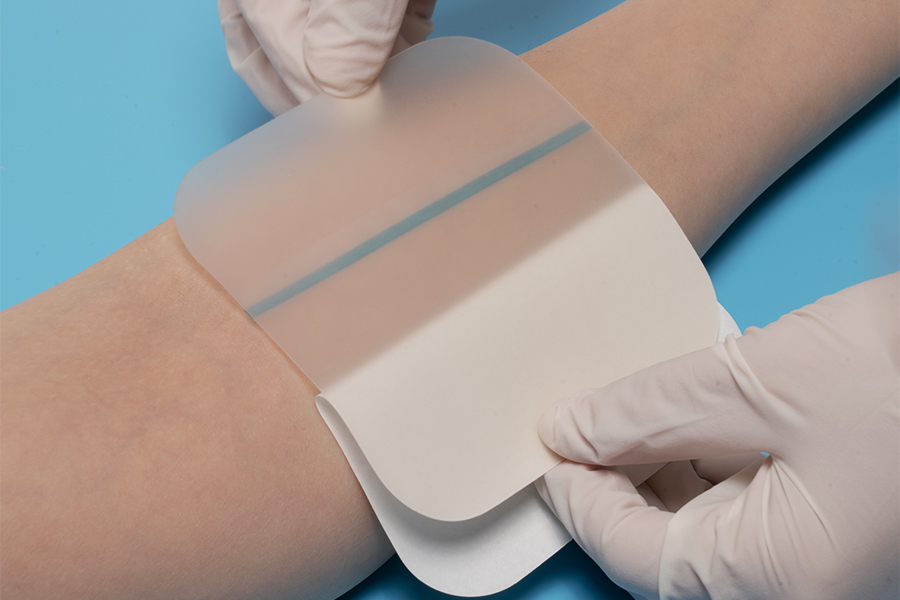Hydrocolloid dressings are highly effective in preventing infection while maintaining a moist wound healing environment. Their unique properties and composition play key roles in creating an optimal setting for wound healing and minimizing the risk of infection. Here's how they work:
1. Moisture Retention and Barrier Formation
Moist Healing Environment: Hydrocolloid dressings maintain a moist wound environment, which is crucial for the healing process. This environment helps by:
Promoting cell migration: Moisture helps cells involved in wound healing, such as fibroblasts and epithelial cells, to migrate more efficiently across the wound bed.
Minimizing scab formation: When the wound is kept moist, the formation of a scab (which can act as a physical barrier to healing) is prevented, allowing for faster and smoother healing.
Waterproof Barrier: Hydrocolloid dressings form a semi-occlusive barrier over the wound, protecting it from external contaminants, bacteria, and other environmental factors that could lead to infection. The outer layer is typically waterproof, which keeps harmful microorganisms out while allowing excess moisture from the wound to be absorbed by the dressing.
2. Absorption of Exudate
Absorption of Excess Moisture: Hydrocolloid dressings are designed to absorb exudate (fluid that leaks out of the wound), which can contain bacteria, debris, and other potentially harmful substances. By absorbing this fluid, hydrocolloids:
Control the moisture balance: They prevent the wound from becoming overly wet, which can lead to maceration (softening and breakdown of the skin around the wound), a condition that can increase the risk of infection.
Trap and contain bacteria: The dressing’s absorptive capacity allows it to trap bacteria within the gel-like matrix formed inside the dressing, keeping the wound bed isolated from external pathogens.
3. Prevention of Bacterial Penetration
Occlusive Layer: The inner hydrocolloid layer creates a moist gel as it absorbs exudate, which not only keeps the wound moist but also creates a physical barrier against bacteria. This barrier prevents pathogens from entering the wound and helps to reduce the risk of infection.
Adhesion Without Adhesive Irritation: Hydrocolloid dressings have a gentle adhesive layer that allows them to stay in place without causing trauma to the wound site during dressing changes. By maintaining the seal around the wound, they reduce the chances of contaminants entering from the edges, which could lead to infection.

4. Bacterial Growth Inhibition
Some hydrocolloid dressings contain antimicrobial agents like silver or iodine within their composition. These agents help to:
Prevent bacterial growth by creating an inhospitable environment for microbes.
Inhibit the proliferation of bacteria and other pathogens, especially in highly exudating or infected wounds.
The incorporation of antimicrobial substances ensures that the dressing not only prevents external contamination but also limits the risk of infection from pathogens that might already be present in the wound.
5. Reduced Risk of Biofilm Formation
Biofilm is a cluster of bacteria that forms a protective layer over wounds, making them harder to treat and more prone to infection. The moist environment provided by hydrocolloid dressings can:
Prevent the conditions necessary for biofilm formation, particularly by reducing the presence of dead tissue and keeping the wound moist.
Enhance wound healing by maintaining a clean and controlled wound environment, thus reducing the likelihood of bacteria aggregating and forming biofilms.
6. Non-Adherence to Wound Bed
Hydrocolloid dressings are designed to not adhere to the wound bed, meaning they do not disturb the newly formed tissue during dressing changes. This property reduces the risk of trauma to the wound site, which could otherwise create open paths for infection to enter. Since the dressing remains intact and does not stick to the wound, it also helps to preserve a sterile environment around the wound, reducing exposure to pathogens.
7. Protection from Contamination
Hydrocolloid dressings also act as a physical shield from dirt, dust, and other environmental contaminants. The outer layer is typically resistant to water, bacteria, and viruses, which helps to keep the wound safe from external sources of infection.
This barrier effect is particularly beneficial in high-risk settings, such as when a wound is exposed to potential contaminants (e.g., surgical wounds, traumatic injuries, pressure ulcers).
8. Reduced Dressing Changes
Since hydrocolloid dressings are designed to be durable and stay in place for longer periods (typically several days), they reduce the frequency of dressing changes. This is important because frequent dressing changes can expose the wound to infection risk due to the interruption of the wound’s protective barrier and the potential for contamination during handling.
Fewer dressing changes also minimize patient discomfort and help maintain a stable healing environment, thereby contributing to reduced infection risk.

 English
English 中文简体
中文简体








